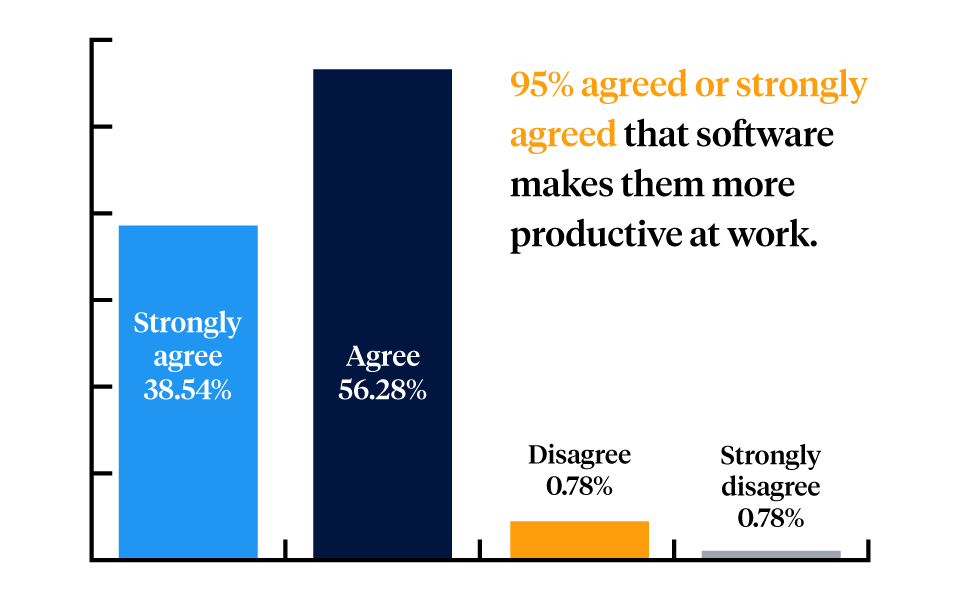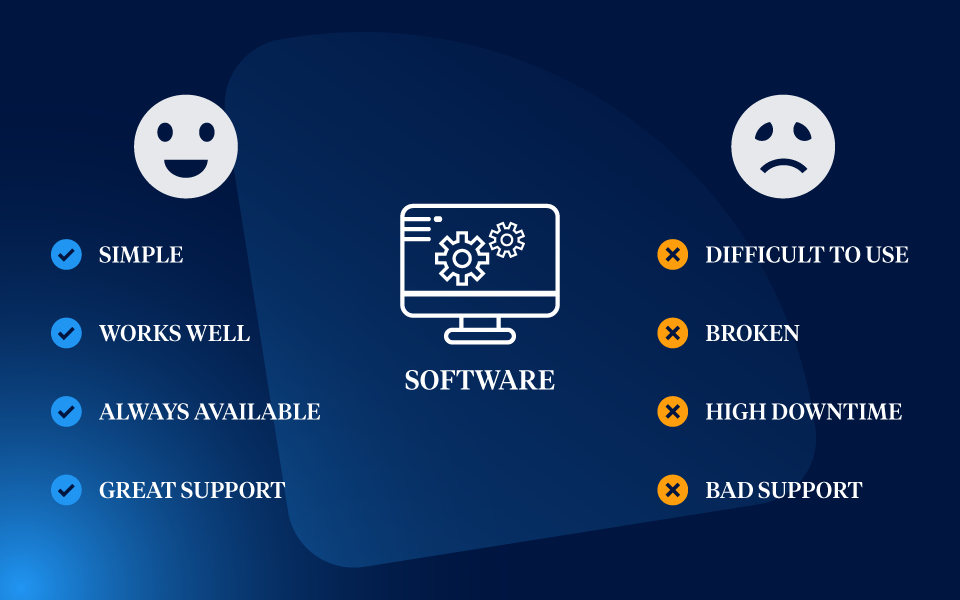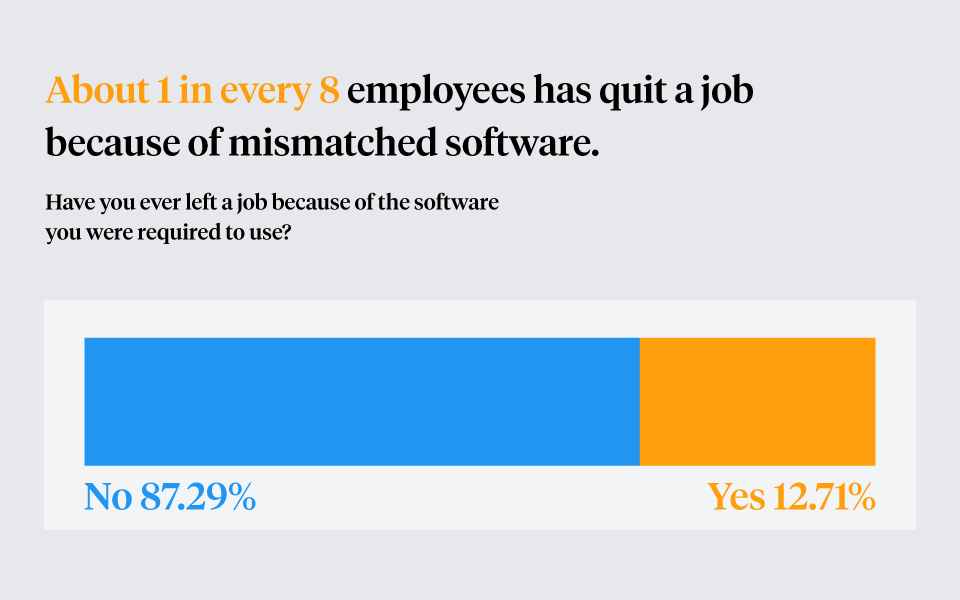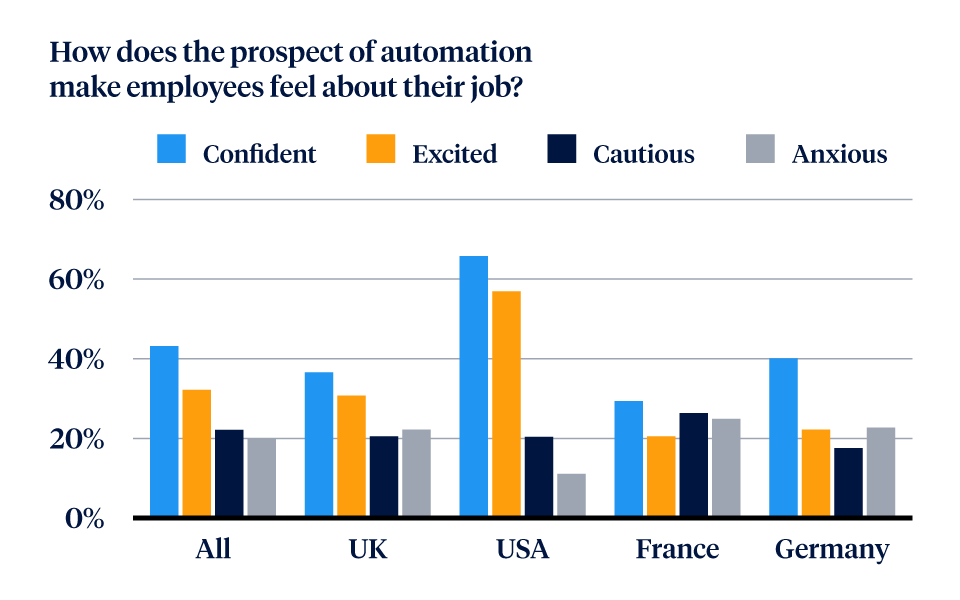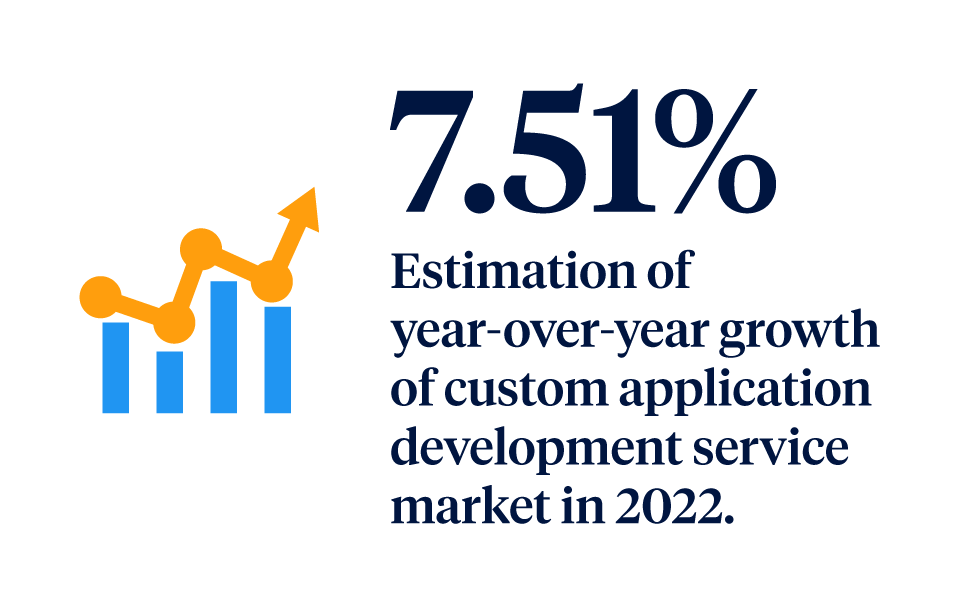Why Good Software May Be the Secret to Keeping Employees Happy
Table of Contents
It’s not every day you hear of a software bug resulting in divorce, but we live in extraordinary times.
An adulterous businessman in southern France recently sought damages of up to €45m from Uber over his wife’s discovery of his extra-marital affair.
The plaintiff, hailing from the lavish French Riviera, says he once logged into his Uber account via his wife’s phone to request a driver.
But despite using the log-off function, the application continued to push notifications to his wife’s device long after completing his original ride. The notifications revealed his suspicious travel history, ultimately proving his infidelity.
The couple has since divorced, but the drama continues in court.
“My client was the victim of a bug in an application,” his lawyer David-André Darmon told the AFP international news agency.
“There’s a function to disconnect, but the session was not disconnected, and the bug has caused him problems in his private life,” Darmon added.
A clear case of Uber being liable for the dissolution of a marriage? You be the judge.
While the example above may be an extreme case of the implications that can occur when software behaves in unintended ways, we’ve likely all been in the spot where technology has frustrated us. Maybe you’re in a remote location when your GPS fails to load, or you’re in the middle of an important presentation when your system crashes.
Whatever the circumstances, we’ve all been at the mercy of an untimely glitch. But ironically, software is supposed to make our lives easier and happier, especially at work.
The Impact of Happiness at Work
In the last decade, employee happiness has increasingly become essential to businesses. Further, there is mounting evidence that shows organizations prosper when their employees are happy. One recent study determined that employee happiness increases almost every business outcome: raising sales by 37%, productivity by 31%, and accuracy on tasks by 19%.
How to Measure Happiness at Work
Suppose we lean into the theory that employee happiness correlates directly with positive business outcomes. In that case, businesses should monitor and measure happiness and even designate it as a key performance indicator. But how can companies effectively measure happiness?
One strategy is to utilize a happiness quotient (HQ), which measures the approximate happiness of each employee and the happiness levels of the organization as a whole. The technique surveys employees and examines larger trends like absenteeism, turnover, and employee performance to paint a broader picture of organization-wide happiness.
These quotients also examine how employees spend their working hours. And predictably, most white-collar professionals spend the majority of their days in front of screens. So much so that a recent study revealed that professionals average 28 hours each week interacting with technology and software, equating to 70% of their available time.
If so, white-collar professionals spend more than two-thirds of their working hours using software. That makes it imperative that this time is spent using good software. In other words, solutions that are simple to use, make their jobs easier, and after time, become an essential tool for business continuity. But the problem is that not all software solutions are created equal—in plain English; there’s a big difference between good and bad software.
‘Good’ Software versus ‘Bad’ Software
When examining whether a particular software solution is good or bad, users should take a note from world-renowned organizational guru Marie Kondo. Kondo’s famous decluttering strategy requires participants to ask themselves one essential question before deciding whether to remove an item from their household: does it spark joy?
Similarly, software users should be asking the question, “does it make my job easier?” If the answer is a resounding no, it’s time to assess seriously whether your chosen tool is impacting critical business functions. When organizations spend money on unreliable software that breaks repeatedly and demands big efforts for small gains, it’s time to consider an alternative. If you need to expend the same energy to accommodate your software as you would to do the job manually—it’s bad software.
On the other hand, good software reduces or eliminates repetitive tasks and manual labor. The best B2B SaaS solutions solve pain points and help businesses operate more efficiently and effectively. Good software’s virtues will be often backed by extensive reviews, testifying to cases of increased productivity, reduced human error, and better decision-making. Science shows these gains all result in increased levels of professional happiness.
Why Easy-to-Use Software is Critically Important for Your Business
When software is easy-to-use, it should be intuitive from the get-go. This doesn’t mean that it isn’t complex or feature-rich; it just means that the best solutions often feel instinctual. Usability is important because it facilitates adoption, enhances efficiency, and helps employees complete tasks faster with less frustration and fatigue.
When good software can prevent repetitive annoyances, workers are much less likely to feel uninspired and unhappy. Preventing this cycle should be paramount for businesses as unhappy employees are far more likely to produce low-quality work because their investment in the company has plummeted.
The data tells a similar tale. A recent G2 survey polled more than 1,600 people to better understand the effects software can have on employee experience. Concerningly, more than half of those surveyed reported being unhappy at work due to software frustrations citing ease-of-use as a central theme.
Even more worrisome, roughly 25% of those surveyed reported that the software they were required to use at work has made them consider leaving their jobs. And when asked if those eventually left, more than 12% reported quitting over software frustrations.
Overall, the majority of employees surveyed indicated that their happiness at work could be impacted by having the correct software for their role and, to a lesser extent, more software to do their job effectively.
A Well Crafted UI/UX
User interface (UI) design and user experience (UX) play vital roles in determining the quality and effectiveness of software. Frequently, these two pursuits operate alongside each other, but it’s important to understand they are distinct. UX design refers to the overall experience of the software, whereas UI design focuses on how the product interfaces appear and function. In essence, effective UX design solves the user’s problems while UI layers on intuitive, aesthetically pleasing interfaces.
And just like people, first impressions count for a lot. End users will often form opinions based purely on their first experience, so achieving a positive visual aesthetic is important.
For example, the selection and design of visual elements such as colors, fonts, spacing, text boldness, number of items on the screen, icons, and images all play a role in determining effective UI/UX design. A skillfully designed interface should provide visual clues to users about how to take the next steps such as clicking a button to run a report.
On the other hand, bad UI/UX design requires users to spend a lot of mental energy to figure out what to do next. This ambiguousness can result in a frustrating and confusing experience that, at worst, can cause a user to abandon the software altogether and perhaps even their job.
The Results of Good Software
Now that we understand why good software is so closely correlated with employee happiness, let’s examine some of the specific benefits that result from a successful implementation. Below are six results organizations can expect when they invest in good software:
A Supported Remote Workforce
During the pandemic, workforces were forced to quickly pivot to remote environments and relied heavily on good software solutions as lifelines for work continuity. If your business had yet to implement robust software by March 2020, you were likely left scrambling for ways to ensure your workers could continue to be effective. Cloud-based platforms like Slack and Asana helped teams operate faster and stay in sync, whereas those stuck with on-prem software were left frantically looking for good tools.
Fast forward just a few years, and the efficacy of remote work has been conclusively established, and a new way of working has ultimately taken hold. New data reveals that remote work positively influences engagement, satisfaction, and performance, and in many cases, reduces stress. Ironically, through some of the darkest days in the pandemic, work-from-home benefits ultimately increased the happiness of many professionals.
Today, these same workers are fully embracing a permanent hybrid model so they can continue to access some of the most impactful benefits, including less commuting time, better work/life balance, and increased financial savings. Additionally, a survey by a research website, Tracking Happiness, found that the ability to work remotely is positively correlated with employee happiness, with fully remote workers reporting a happiness level roughly 20% higher than those who worked in the office 100% of the time.
Better Decision-Making Backed by Data
When businesses invest in good software solutions, leaders no longer have to search endlessly for the information they need to make data-informed decisions; it’s all at their fingertips. Without good tools, they are unable to surface some of their most important metrics readily. And with the advent of SaaS analytics, businesses can now capture and analyze more data than ever, resulting in intelligence that helps them make real-time decisions to support their bottom lines.
When decision-making is made easier by software, organizations can test the success of different strategies and build more paths toward sustainable growth. Today, some of the most exciting software platforms have business intelligence and analytics tools embedded directly within their interfaces, providing leaders with easy-to-use tools that drive success and, ultimately, happiness for themselves and their organizations.
Regained Time From Automation
As the old saying goes, time is money—so when businesses can eliminate repetitive administrative overhead, it dramatically reduces the burden on employees. The best B2B software solutions will often include automation features that can impact employee happiness by reducing repetitive, manual jobs.
Basic automation is about digitizing work to streamline and centralize workflows, thereby avoiding siloed information or excessive work in spreadsheets. Ideally, this frees employees to lean more heavily into the specialized work they have trained for, making them feel more fulfilled and engaged with their jobs.
According to a recent study from Tradeshift, finance workers who have incorporated high levels of automation into their daily tasks are happier in their jobs, more hopeful about their future career prospects, and more likely to speak highly of their industry to a peer.
Source:
Additionally, the research revealed that 71% of respondents believed automation positively impacts their job satisfaction. And although 25% of employees felt technology could one day eliminate their job role in its current form, a clear majority (63%) believed key aspects of their job would always require a human touch.
Increased Value From Customization
In 2023 and beyond, customization is another software trend gaining traction. You may initially wonder if customizing your software will be time-consuming and expensive, but the truth is that investing time and money into developing the perfect solution for your team will likely yield you a higher return on investment. In other words, you’ll get more bang for your buck.
Custom software options can truly revolutionize businesses, and as a result, it’s a trend quickly picking up steam. According to a study by Technavio, the custom application development service market is expected to grow by 7.5% year on year. This spotlights the growing demand from companies as they recognize its value and evolving capabilities.
Source:
Businesses shouldn’t have to adjust their established processes around any software’s limited capabilities. Good software can adjust to the organization’s needs and often drives customer loyalty. For example, product personalization is essential when delivering a tailored customer experience to a business. Clients often participate in the development process, making them feel heard, acknowledged, and happy.
Peace of Mind with Data Security
Today, most businesses are savvy enough to understand that, at the very least, they need the most basic cybersecurity protections. You should rightfully expect your software to keep your data safe from hackers. Moreover, good software should prevent any sensitive data from being shared with end users, internally or externally, such as employees’ financial or personal information. Additionally, built-in safeguards should exist to ensure that catastrophic mistakes aren’t made by users like accidentally deleting a client’s account.
The world is more dangerous than ever, and cyber threats are becoming more sophisticated. Today, bad software could easily become a gateway for viruses to enter and disrupt your systems. Because many businesses house confidential information in digital form, it’s essential to ensure your software is secure and compliant in the face of regulations such as GDPR.
With so much at stake, it’s crucial businesses do their due diligence when researching their software options so after implementation, they have peace of mind that all of their confidential data is protected.
Improved Experience by Utilizing Customer Success Teams
Today, online review platforms like Capterra and G2 offer a wealth of user experience you can refer to during the software selection process. Even so, it can become hard to distinguish which platform best suits your business due to all the marketing noise. However, one of the most underrated considerations during the purchasing process is weighing the quality and accessibility of a software provider’s Customer Success Team.
Nothing is more frustrating than running into a brick wall when you can’t reach a specialist to help solve your problem. Good software should include access to Customer Success Specialists who understand that their clients are people who care about their organization. A recent study showed that for every customer who contacts Customer Success, 26 customers with a problem don’t reach out. And of those, research also shows that 91% who don’t utilize their Customer Success Teams simply churn. Frustratingly, these businesses then restart their software search having wasted both time and money.
Achieving Happiness at Work
Work is an essential source of our self-image and self-confidence, not to mention our livelihood. And with so much of our time spent using software, it’s important to choose good solutions that prove to be effective. Today, businesses have myriad options for selecting software that promises to eliminate the most monotonous parts of our job. But by choosing good software, organizations can thrive while employees invest more hours into the work they genuinely care about. In turn, this leads to higher levels of satisfaction, achievement, and happiness in the workplace.



